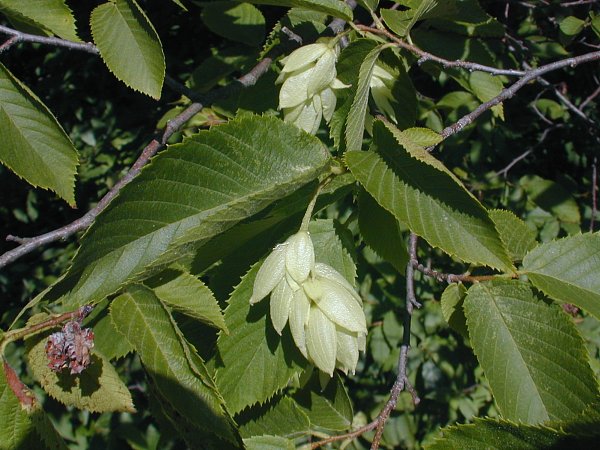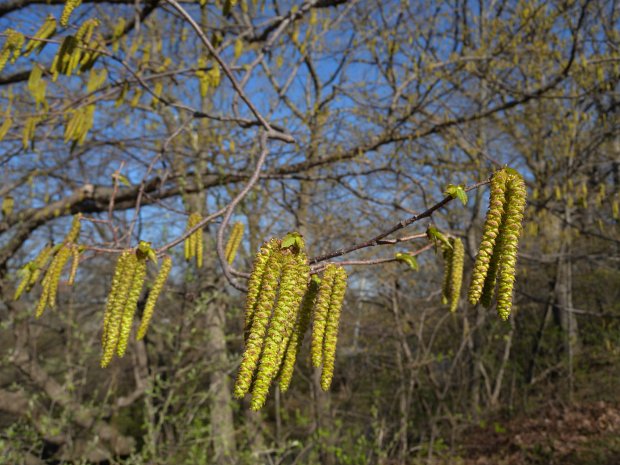Description: This medium-small tree is up to 50' tall; it has a finely branched rounded crown. The trunk is up to 2' across. On mature trees, the bark of the trunk is rough-textured and greyish brown, dividing into narrow rectangular strips; this provides the trunk with a slightly shaggy appearance. The bark of smaller branches is more smooth and gray with small lenticels. The alternate leaves are 3-5" long and 1½–2½" across; they are ovate, pinnately veined, and doubly serrated along their margins. Each leaf tapers rather abruptly into a slender tip. The upper leaf surface is medium green and largely devoid of hairs, while the lower surface is pale green and slightly to moderately pubescent. The slender petioles are about ½" long, light green, and slightly to moderately pubescent. Because Hop Hornbeam is usually monoecious, the same tree has separate male and female flowers in the form of catkins. On rare occasions, some trees are unisexual. The male catkins are 1-2" long and narrowly cylindrical in shape; they are often arranged in groups of 3 and droop downward. The female catkins occur individually at the ends of branches; they are about ½" long and broadly cylindrical. The blooming period occurs during mid- to late spring. Cross-pollination of the flowers is achieved by wind. Afterwards, the inflorescence of female flowers begins to swell into a drooping compound fruit about 1½–2½" long and ¾–1" across; it has an appearance that is similar to the fruit of a hop vine. The nutlets of this fruit are enclosed within overlapping inflated sacs that are ovoid and somewhat flattened in shape. Initially, these sacs are greenish white and slightly shiny, but they later become dull brown. The woody root system produces no vegetative offsets; this tree reproduces by reseeding itself into new areas.

Cultivation: Hop-Hornbeam adapts to many different situations, including those with full sunlight to light shade, moist to dry conditions, and soil containing loam, clay, or rocky material. This tree is slow to develop and its wood is strong and hard.
Range & Habitat: This tree can be found in all counties of Illinois (see Distribution Map), where it is native and fairly common. Typical habitats include mesic to dry deciduous woodlands, woodland edges, limestone glades, rocky wooded slopes, edges of cliffs, edges of wooded bluffs, and abandoned fields. Hop Hornbeam is usually found in upland wooded areas. It is uncommonly cultivated as a lawn tree.

Faunal Associations: Many insects use Hop Hornbeam as a source of food by boring through the wood, sucking the sap, eating the leaves, etc. These insects include the larvae of metallic wood-boring beetles, larvae of long-horned beetles, weevils, plant bugs, leafhoppers, armored scales, larvae of sawflies, and larvae of moths. The Insect Table provides more information about these insects. The nutlets of this small tree are a source of food for several bird species. This includes the Ruffed Grouse, Wild Turkey, Ring-necked Pheasant, Bobwhite Quail, Purple Finch, and Rose-breasted Grosbeak. Some of these birds also feed on the buds and catkins of this tree also. Mammals that are known to eat the nutlets include the White-footed Mouse, Deer Mouse, and Fox Squirrel, while White-tailed Deer feed on the twigs during winter (Martin et al., 1951/1961; DeGraaf, 2002; Bennetts, 1900; Hamilton, 1941). Young Screech Owls sometimes select this tree as a roost site (Belthoff & Ritchison, 1990).

Photographic Location: Crystal Lake Park in Urbana, Illinois, at the top of a wooded slope.
Comments: Another common name of this tree is Ironwood. It is easy to identify Hop Hornbeam (Ostyra virginiana) from its attractive and persistent hop-like fruits. In Illinois, its closest relative is another medium-small tree, Carpinus caroliniana (American Hornbeam). This latter tree has very smooth bark on its trunk, even when it is fully mature. The fruiting structures of American Hornbeam are distinct from the inflated sacs of Hop Hornbeam; the nutlets of American Hornbeam are subtended by 3-cleft bracts that are flat and open.